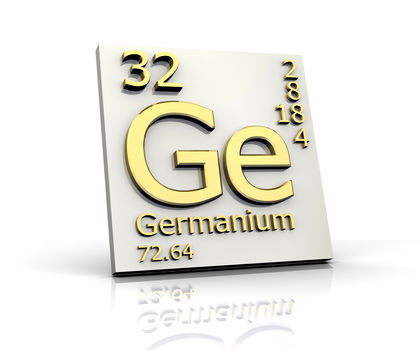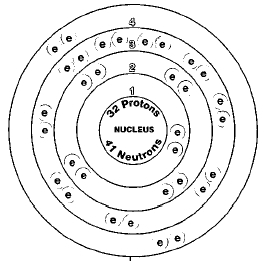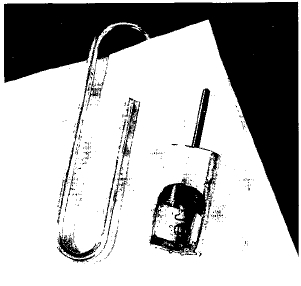GERMANIUM


Overview
Germanium is a metalloid. A metalloid is an element that has characteristics of both metals and non-metals. Germanium is located in the middle of the carbon family, which is Group 14 (IVA) in the periodic table. The periodic table is a chart that shows how chemical elements are related to each other. Carbon and silicon are above germanium and tin and lead are below it.
The existence of germanium was predicted by Russian chemist Dmitri Mendeleev (1834-1907), who developed the periodic table. Mendeleev predicted a new element would be found to fill an empty spot on the table. He was proved correct in 1886.
Until the 1950s, there were no important uses for germanium. Then, the transistor was invented. A transistor is a device used to control the flow of electricity in a circuit. Today, germanium is used in making a number of electronic devices, including the transistor.
SYMBOL
Ge
ATOMIC NUMBER
32
ATOMIC MASS
72.59
FAMILY
Group 14 (IVA)
Carbon
PRONUNCIATION
jur-MAY-nee-um
Discovery and naming
In the 1860s, Mendeleev wondered if the chemical elements could be arranged in any systematic way. Are all chemical elements very different from each other, he asked. Do they have certain common properties?
He explored a number of ways of arranging the elements. Finally, he decided to arrange them according to their atomic weights. He found that doing so resulted in a pattern. After awhile, each element could be placed in a position beneath one or more elements before it. Mendeleev described his result in the periodic law. The periodic table is the most common way of illustrating the periodic law. Elements that are similar to each other fall into the same group. For example, the elements in Group 1 (IA) are like each other in many ways.
Mendeleev found that his periodic table made sense, however, only if he left some blank spaces in it. His table had a blank space for element number 32. No element existed that had properties like silicon (number 14) and could be put beneath it in the periodic table.
This finding did not disturb Mendeleev. Element number 32 simply had not been discovered yet, he said.
A number of chemists took up Mendeleev's challenge. In 1885, a new ore was discovered in a mine near Freiberg, Germany. Silver and sulfur were found in the ore, but about seven percent of the ore could not be identified. The ore was sent to German chemist Clemens Alexander Winkler (1838-1904). At the time, Winkler was professor of chemical technology and analytical chemistry at the Freiberg School of Mines. He was convinced that the new ore contained a new element. He isolated the new element from the ore and named it germanium, in honor of Winkler's native country, Germany.
Winkler discovered that the properties of germanium were very similar to those that Mendeleev had predicted 15 years earlier. For example, Mendeleev thought element 32 would have a density of 5.5 grams per cubic centimeter. The actual density for germanium is 5.47 grams per cubic centimeter. Mendeleev had based his predictions on the new element's place in the periodic table. His success in making these predictions gave chemists a great deal of confidence in the periodic table. They came to see how useful it could be in their research.

Physical properties
Germanium looks like a metal. It has a bright, shiny, silvery color. But it is brittle and breaks apart rather easily, which metals normally do not do. It has a melting point of 937.4°C (1,719°F) and a boiling point of 2,830°C (5,130°F). It conducts an electric current poorly. Substances of this kind are called semiconductors. Semiconductors conduct an electric current, but not nearly as well as metals like silver, copper, and aluminum.
The ability of semiconductors to conduct electricity depends greatly on the presence of small amounts of impurities. The addition of an impurity to a semiconductor is called doping. Doping a semiconductor has significant effects on its ability to conduct an electric current.
Chemical properties
Germanium is a relatively inactive element. It does not dissolve in water
and does not react with
oxygen
at room temperature. It does dissolve in hot acids and with oxygen at
high
temperatures, however. It becomes more active when finely divided. It
will combine with
chlorine
and
bromine
to form germanium chloride (GeCl
4
) and germanium bromide (GeBr
4
). For example:
Occurrence in nature
The abundance of germanium in the Earth's crust is estimated to be about 7 parts per million. That places it in the bottom third of the elements arranged according to their abundance.
The two most common minerals of germanium are argyrodite and germanite. Argyrodite is the mineral in which Winkler first discovered germanium. Germanite contains about 8 percent germanium.
Most germanium today is obtained from zinc ores. When those ores are treated to obtain zinc metal, some germanium is produced at the same time.
Germanium is obtained from two mines in the United States. One mine is in Alaska and the other is in Tennessee. The United States also imports germanium from China, the United Kingdom, Ukraine, Russia, Belgium, and other nations.
Isotopes
There are five naturally occurring isotopes of germanium: germanium-70, germanium-72, germanium-73, germanium-74, and germanium-76. Isotopes are two or more forms of an element. Isotopes differ from each other according to their mass number. The number written to the right of the element's name is the mass number. The mass number represents the number of protons plus neutrons in the nucleus of an atom of the element. The number of protons determines the element, but the number of neutrons in the atom of any one element can vary. Each variation is an isotope.
It is possible to buy germanium that is 99.9999 percent pure. This level of purity is needed in order to use the metal in the production of semiconductors.
At least nine radioactive isotopes of germanium are known also. A radioactive isotope is one that breaks apart and gives off some form of radiation. Radioactive isotopes are produced when very small particles are fired at atoms. These particles stick in the atoms and make them radioactive.

None of the radioactive isotopes of germanium has any important commercial use.
Extraction
Germanium in zinc ores is heated in the presence of chlorine gas.
Germanium chloride (GeCl
4
) is formed:
Pure germanium metal is then produced by passing an electric current
through molten (melted) germanium chloride:
This method produces very pure germanium. It is possible to buy germanium that is 99.9999 percent pure. This level of purity is needed in order to use the metal in the production of semiconductors.
Uses
Germanium first became important for its use in semiconductors. This still accounts for about 15 percent of the germanium produced. But other uses of the element are now more important. About 40 percent of the germanium produced in the United States is now used in the manufacture of fiber optic systems.
An optical fiber is a very thin thread made out of pure glass. The fiber acts somewhat like a copper wire. It can carry messages in the same way a copper wire carries messages. The difference is that optical fibers carry messages on light waves. Copper wires carry messages on electric currents.
The ability of a glass thread to carry light depends on the presence of impurities. Optical fibers are doped with germanium and other elements to improve their ability to carry light messages. Optical fibers are now used to carry telephone messages instead of electric wires.
Germanium is also used as a catalyst. A catalyst is used to speed up or slow down a chemical reaction. The catalyst does not undergo any chemical change during the reaction. Germanium catalysts are used primarily in the production of plastics.
Germanium is also used to make specialized glass for military applications. For example, it is used to make weapons-sighting systems that can be used in the dark. Satellite systems and fire alarm systems may also contain glass that contains germanium.
Compounds
Few germanium compounds have any important commercial uses.
Germanium is used to make weapons-sighting systems that can be used in the dark.
Health effects
Germanium is not thought to be essential to the health of plants or animals. Some of its compounds present a hazard to human health, however. For example, germanium chloride and germanium fluoride (GeF 4 ) are a liquid and gas, respectively, that can be very irritating to the eyes, skin, lungs, and throat.